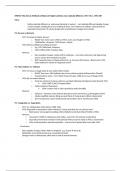Other
How far do you agree that The Aims & Methods of Black civil rights activists were radically different, 1917-55 vs. 1955-68?
- Institution
- PEARSON (PEARSON)
How far do you agree that The Aims & Methods of Black civil rights activists were radically different, 1917-55 vs. 1955-68? Unit 1F - In search of the American Dream: the USA, c1917-96? Pearson edexcel history comprehensive essay plan
[Show more]



